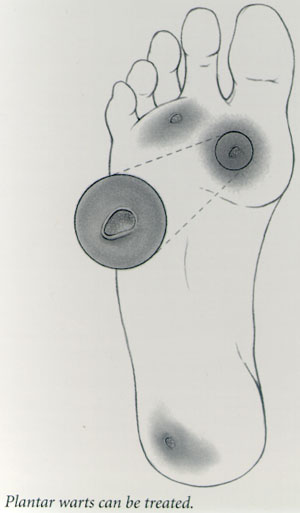
Plantar Warts
Source: American Academy of Orthopedic Surgeons
Synopsis
Plantar warts are a common skin infection on the bottom (plantar) side of your foot. About 10 percent of teenagers have warts. Using a public shower or walking around the locker room in your bare feet after a workout increases your risk for developing plantar warts.

Cause and symptoms
Contrary to the old folk tale, you canít get warts from touching a toad. Warts are caused by a virus that enters the body through a break in the skin. The virus grows in warm, moist environments, such as those created in a locker room or in your shoes when your feet perspire and the moisture is trapped. Plantar warts often spread to other areas of the foot, increase in size, and have "babies," resulting in a cluster that resembles a mosaic.
Plantar warts can erupt anywhere on the sole of the foot. They may be difficult to distinguish from calluses. However, you may be able to see tiny black dots on the surface layer of a plantar wart. These are the ends of capillary blood vessels. Calluses have no blood vessels, usually resemble yellow candle wax and are located only over weightbearing areas.
Plantar warts can be very painful and tender. Standing and walking push the warts flat. They grow up into the skin, making it feel like thereís a stone in your shoe.
Treatment
Although plantar warts may eventually disappear by themselves, you should seek treatment if they are painful. Your physician will carefully trim the wart and apply a chemically treated dressing. The physician will also give you instructions for self-care. Salicylic acid patches, applied on a daily basis, and good foot hygiene, including regular use of a pumice stone, are often all that is needed. However, it may take several weeks for the wart to disappear completely.
Another common method is the use of duct tape. in most mild to moderate cases duct tape can be up to 85% effective in treating warts, tape may be applied to the site and left for about 6 days, on the sixth day remove the tape soak the area in water and gently use an emory board or pumice stone to remove the wart. leave the tape off over night and repeat this process until the wart resolves. there are two main schools of thought on how this works, some doctors believe the tape cuts off the vascular and air supply to the wart in essence killing it, while other doctors believe the chemicals found in the tape may be a part of the process. still others believe its a combination of both factors.
If the wart is resistant to treatment, your physician may recommend an office procedure to remove it. After a local anesthetic is applied, the physician may use liquid nitrogen to freeze the wart and dissolve it. To avoid scarring or damaging other tissues, this method removes only the top portion of the wart. The treatment must be repeated regularly until the entire wart is dissolved. Alternatively, the physician can cut out (excise) the wart.
Prevention
To reduce your risk for getting plantar warts, be sure to wear shower thongs or sandals when you use a public locker room or shower. Use foot powders and change your socks frequently to keep the feet dry.